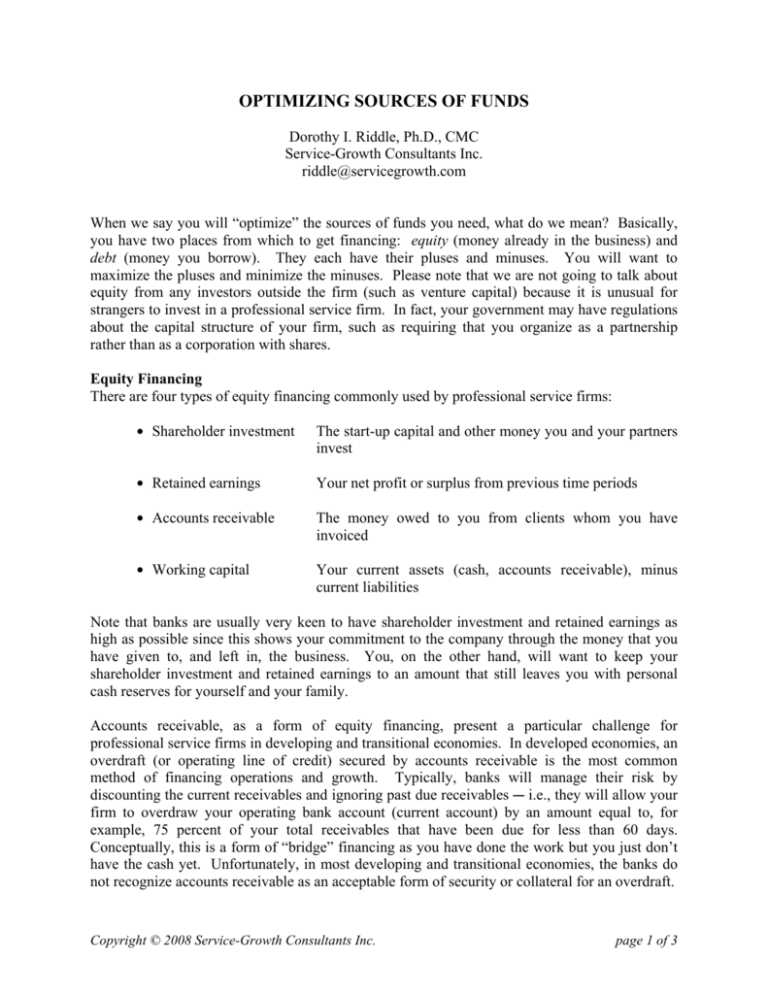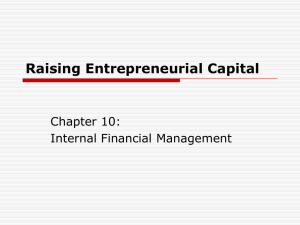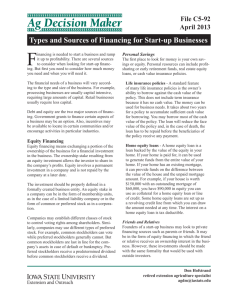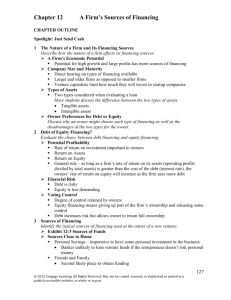OPTIMIZING SOURCES OF FUNDS
advertisement

OPTIMIZING SOURCES OF FUNDS Dorothy I. Riddle, Ph.D., CMC Service-Growth Consultants Inc. riddle@servicegrowth.com When we say you will “optimize” the sources of funds you need, what do we mean? Basically, you have two places from which to get financing: equity (money already in the business) and debt (money you borrow). They each have their pluses and minuses. You will want to maximize the pluses and minimize the minuses. Please note that we are not going to talk about equity from any investors outside the firm (such as venture capital) because it is unusual for strangers to invest in a professional service firm. In fact, your government may have regulations about the capital structure of your firm, such as requiring that you organize as a partnership rather than as a corporation with shares. Equity Financing There are four types of equity financing commonly used by professional service firms: $ Shareholder investment The start-up capital and other money you and your partners invest $ Retained earnings Your net profit or surplus from previous time periods $ Accounts receivable The money owed to you from clients whom you have invoiced $ Working capital Your current assets (cash, accounts receivable), minus current liabilities Note that banks are usually very keen to have shareholder investment and retained earnings as high as possible since this shows your commitment to the company through the money that you have given to, and left in, the business. You, on the other hand, will want to keep your shareholder investment and retained earnings to an amount that still leaves you with personal cash reserves for yourself and your family. Accounts receivable, as a form of equity financing, present a particular challenge for professional service firms in developing and transitional economies. In developed economies, an overdraft (or operating line of credit) secured by accounts receivable is the most common method of financing operations and growth. Typically, banks will manage their risk by discounting the current receivables and ignoring past due receivables C i.e., they will allow your firm to overdraw your operating bank account (current account) by an amount equal to, for example, 75 percent of your total receivables that have been due for less than 60 days. Conceptually, this is a form of “bridge” financing as you have done the work but you just don’t have the cash yet. Unfortunately, in most developing and transitional economies, the banks do not recognize accounts receivable as an acceptable form of security or collateral for an overdraft. Copyright © 2008 Service-Growth Consultants Inc. page 1 of 3 If you must eliminate accounts receivable as a form of equity financing, this leaves you with the cash in your bank accounts less what you owe to creditors (current liabilities). Before using your cash reserves, you need to determine what amount of cash you need to always have on hand. For example, some firms stipulate that they must keep the equivalent of two months’ operating costs. Debt Financing When it comes to borrowing money, you can either borrow internally (i.e., from yourself, your family and your business partners) or externally (i.e., from your bank, creditors, and clients). Some of these options are free while others entail interest and handling charges. Generally speaking, you want to keep your debt within what you can comfortably repay. Experience shows that a debt-equity ratio (i.e., total liabilities divided by total equity) of 2 to 1 is about as high as you would want to go. If you rely on internal borrowing, you have the most flexibility. Often such loans are interestfree or at a nominal interest rate. You can delay repayment without incurring financing charges or jeopardizing your credit rating with your banker. But there is probably a limit to your own resources. Some professionals talk about a “glass ceiling” of their own asset base beyond which it is difficult to support a firm’s growth. So you will likely also need external debt financing. And you probably thought first of your bank because lending money is, after all, their business. Yes, banks lend money, but they want to make money at it. They want to be very sure that you are a good risk and will repay the money, and so you will need to prepare a proposal for them. To make a favourable impression on a banker, you need to do four things: (a) prepare adequate financial statements so that the banker can analyse your circumstances, (b) keep the banker well informed about your business and its prospects, (c) let the banker know ahead of time if you anticipate any problems and how you plan to handle them, and (d) always pay what you owe on time or negotiate new terms of payment. There are two types of short-term loans that you can get: a revolving loan or overdraft facility, and a term loan. The first is more attractive for you because it means that, once you establish your creditworthiness, you can continue to borrow and repay as needed. In negotiating the terms of a loan, be sure to ask not only about the interest rate but also about administrative fees (e.g., front-end fees for evaluating your request and setting up the loan, back-office fees per disbursement). If you have had a loan with the bank before and can demonstrate that you are a good credit risk, see if you can use your track record to negotiate more favourable terms. Usually your credit rating is not enough to get the size of loan that you need for a company without some form of security. There are four types of security or collateral that your bank might consider: (a) fixed assets such as real estate or vehicles or office equipment; (b) marketable securities such as stocks and bonds; (c) current assets, such as cash in an investment account or your accounts receivable; and (d) other forms of guarantee such as a co-signer or an insurance policy. Please note that often the central bank in your country specifies what types of collateral are acceptable, often restricting collateral to real estate and manufacturing equipment. Copyright © 2008 Service-Growth Consultants Inc. page 2 of 3 Your bank is not the only place to turn for financing. You should also consider different forms of trade credit. First, there are the vendors from whom you purchase your supplies and equipment. Often they will give you 30 days to pay “on account” without charging any interest. Then there are credit card companies. They may begin charging interest sooner than vendors, but they typically allow you to postpone payment as needed and they offer other benefits such as travel insurance when you charge an airline ticket. Wait C did you see “clients” listed as a source of debt financing? Was that a mistake? Certainly not. Many professional service firms assume responsibility for costs unnecessarily. Here are a couple of ideas: Negotiate to receive an advance for contract costs that you will incur. In large capital projects, such an advance is often called a “mobilization” payment. Negotiate to have clients reimburse you for expenses incurred in addition to your professional fee, rather than absorbing those costs. Can you think of others? Copyright © 2008 Service-Growth Consultants Inc. page 3 of 3









